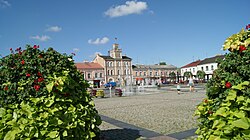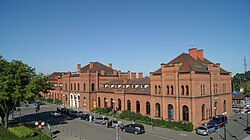Skierniewice
Skierniewice | ||
|---|---|---|
Rynek (Market Square), and Skierniewice railway station | ||
|
Car plates ES,ESK | | |
| Website | http://www.skierniewice.net.pl | |
Skierniewice [skʲɛrɲɛˈvʲit͡sɛ] is a city in central Poland with 47,031 inhabitants (2021),[1] situated in the Łódź Voivodeship. It is the capital of Skierniewice County. The town is situated almost exactly halfway between Łódź and Warsaw. Through the town runs the small river Łupia, also called Skierniewka.
History

The oldest known mention of Skierniewice comes from 1359, although it had existed earlier.

Regained by
During World War I it was occupied by Germany, and after the war, in 1918, it became part of the re-established Polish state. The population increased and economic development started again. A building for the district council was erected. The railway station was rebuilt after the devastation of the war and the district hospital was expanded.
During the
Between 1945 and 1997 the area of the city increased to double and the population increased from 17,524 in 1946 to 47,188 in 1992. Many new factories and thus jobs emerged. From 1975 to 1998, it was the capital of Skierniewice Voivodeship, which led to the establishment of a number of institutions. In 1990, the first free elections to the City Council were held. During the 1999 administrative reform, Skierniewice gained the status of a city with district rights under Łódź county.
The city’s economy is based on the textile industry (dating from the 17th century as a dressmakers’ centre) and the manufacture of farm machinery and electronic products. With an agricultural research institute, it is also known for fruit farming.
Sights
Among the historic sights of Skierniewice are:
- former Episcopal Palace complex with the Park Miejski ("Municipal Park")
- Skierniewice railway station
- churches of Saint James and Saint Stanislaus
- Market Square (Rynek) with the Town Hall (Ratusz)
- Roundhouse Skierniewice
- other historic buildings and structures, including the Kozłowski Villa, now housing the Wedding Palace, and the County Office
-
Episcopal Palace
-
Kitchen building of the Episcopal Palace complex
-
Park Miejski
-
One of the streets of the town centre with historic townhouses and the Saint James church
-
County office
Education
Sports
Unia Skierniewice and Widok Skierniewice football clubs are based in Skierniewice.
International relations
Twin towns – Sister cities
Skierniewice is
|
|
Notable people

Notable people connected with the Skierniewice region:
- Ignacy Krasicki (1735–1801), Roman Catholic archbishop and a writer
- Jan Kozietulski (1781–1821), military commander of the armed forces of the Duchy of Warsaw
- Frédéric Chopin (1810–1849), composer and pianist
- Władysław Reymont (1867–1925), novelist, Nobel Prize Winner for Literature
- Edward Okuń (1872–1945), Polish Art Nouveau painter and freemason
- Polish Army
- Aleksander Narbut-Łuczyński(1890–1977), Polish lawyer and military officer
- Princess Elisabeth of Hesse and by Rhine (1895–1903), German princess
- Szczepan Pieniążek (1913–2008), pomologist
- Itshak Holtz (1925–2018), Jewish genre artist
- Aleksandra Śląska (1925–1989), film actress
- Lech Mackiewicz (born 1960) film director, actor and playwright
- Tamara Arciuch (born 1975), actress
- Monika Mularczyk (born 1980), football referee
- Grzegorz Gajewski (born 1985), chess grandmaster
References
- ^ a b "Local Data Bank". Statistics Poland. Retrieved 19 August 2022. Data for territorial unit 1063000.
- ^ a b c d e f g h i j k l m "Historia Miasta". Skierniewice.eu (in Polish). Retrieved 15 March 2020.
- ^ a b c Szymon Nowak (September 2015). "Niemieckie bombardowania Skierniewic we wrześniu 1939 roku". Opinie WP (in Polish). Retrieved 15 March 2020.
- ^ Wardzyńska, Maria (2009). Był rok 1939. Operacja niemieckiej policji bezpieczeństwa w Polsce. Intelligenzaktion (in Polish). Warszawa: IPN. p. 97.
- ISBN 978-83-8098-174-4.
- ISBN 978-0-253-06089-1.
- ^ Megargee; Overmans; Vogt, p. 88









